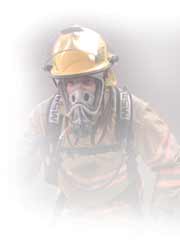Without a doubt,
2001 changed the complexion of firefighting in the United States
forever. The 9-11 Disaster made it painfully clear that fire companies
-- the first responders to terrorist and other catastrophic situations
-- must be outfitted with the right equipment. It also clarified
the need for dependable, ongoing funding that allows fire departments
to plan for and address special requirements.
To respond to these poignant, sobering realities, Congress, through
the Congressional Fire Service Institute, is currently expanding
the FIRE Act program from its current $100 million level to $360
million for 2002. This funding is designated to help cover the costs
of equipment, training, and staffing for 35,000 professional and
volunteer U.S. fire brigades.
 "The
Fire Service Institute has recommended $1 billion in funding for
each of the next six years," remarked Larry Konsin, product group
manager for thermal imaging cameras. "While nobody yet knows what
the funding levels will be in the future, the Institute has used
9-11 to help justify the need for major funding increases." "The
Fire Service Institute has recommended $1 billion in funding for
each of the next six years," remarked Larry Konsin, product group
manager for thermal imaging cameras. "While nobody yet knows what
the funding levels will be in the future, the Institute has used
9-11 to help justify the need for major funding increases."
Additional FIRE Act funds will probably have an impact on types
and quantity of equipment purchased. "Last year, lots of money went
into turnout gear," commented Konsin. "And while it's important
that fire companies have the apparel they need, many people believe
more money will be used this year to purchase durable equipment
-- particularly thermal imaging cameras and other lifesaving devices."
"One important realization to come out of 9-11 was that our firefighters
are really our domestic soldiers here in the U.S.," said Konsin.
"The fire service is our first line of defense when it comes to
terrorism or threats involving nuclear, chemical, or biological
agents. They are charged with looking out for our personal safety.
It's so much more than putting out fires, and MSA joins the federal
government in rising to address those needs."
MSA's sales focus to our fire service customers has been expanded
to include Homeland Security products such as air-purifying respirators
(APRs). However, FIRE Act funding is currently allotted only for
traditional fire service equipment.
"The bottom line -- even if the federal government does commit to
the $1 billion dollar figure for the next six years -- is that we've
only just begun to fully outfit our firefighters. We have a long
way to go to provide every fire department with the equipment and
support they need for all their responsibilities. But along the
way, MSA will be there to help in any way we can."
To keep up with the latest FEMA activities, go to their web site
at www.usfa.fema.gov/grants.
|
Due to the
situations in New York City and Washington, D.C., many fire
departments have seen what thermal imaging technology can
do to improve their performance. Thermal imaging's important
role in firefighting was further confirmed in the December
2001 fire in St. John the Divine Cathedral in Manhattan. Using
the cameras, firefighters were able to identify hot spots
in the dense smoke and confine the fire to the cathedral's
gift shop.
Thermal imaging cameras are also being considered for a wide
range of Homeland Security applications. |
|